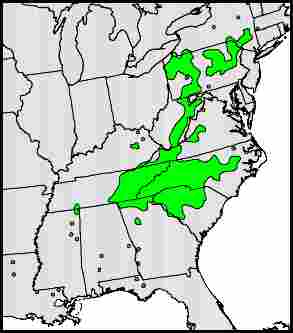Mountain Holly
(Ilex montana)
Mountain holly is a small deciduous tree found mostly at high elevations from southern New England to Georgia. The species is notable for having the largest berries of any native holly, up to one-half inch thick. Usually these berries are orange-red, but red and yellow forms are sometimes seen. They are more oblong than the berries of most hollies.
The fruit often hangs on the tree into mid-winter, leading to the other common name of Mountain Winterberry. Because the berries are available in the coldest months, they are a valuable food for wildlife.
The bark of the tree is an attractive reddish-brown, and its leaves generally turn yellow before dropping in late autumn. As with other hollies, a plant is either male or female, and a female won't produce berries unless a male is nearby.
Ilex montana grows over a large part of the eastern United States, mostly at high elevations. It is still fairly common in some remote mountain areas, but has become hard-to-find in other parts of its range.
This is a good choice for a semi-wild area in open woods. Because the sexes of young plants are difficult to determine, you should plant at least four or five specimens and hope that some are female. Actually, one male can normally pollinate several females, but in most cases you won't know the sex distribution when you do the planting.
Holly berries are consumed by many bird species, including Wild Turkey, Bluebirds, Catbirds, Mockingbirds, Robins, Thrushers, Blue Jays, Cedar Waxwings, and Thrashers. White-tailed Deer eat the foliage and twigs.
Other Information
Scientific Names: Ilex montana, Ilex ambigua var. montana
Common Names: Mountain Holly, Mountain Winterberry, Big-leaf Holly
Plant Type: Small tree
Height: Up to 30 feet
Cultivation Zones: 5 - 8
Native Habitat: Understory and openings in hardwood forests
Native Range: Mostly mountainous areas from southern New England south almost to the Gulf Coast. See distribution map below.
Distribution Map

Range Map Source: U.S. Forest Service. (See General Note C)
Conservation Status: NatureServe lists Ilex montana as Critically Imperiled in Massachusetts and New Jersey, and possibly Vulnerable in Mississippi. The species is officially classified as Threatened by Massachusetts, Endangered by New Jersey, and Exploitably Vulnerable by New York.
Cultivation: Give this plant moist slightly-acid soil with good drainage. It can survive in shade, but will grow faster and produce more berries in a sunny spot. Go to Cultivation for more information.
Related Species: The best-known relative in the U.S. is the American Holly (ilex opaca), one of the most cold-hardy large evergreens and an excellent landscaping plant. Nurseries sometimes sell special female cultivars with glossy leaves and abundant berry production. Two smaller evergreens, Dahoon (ilex cassine) and Yaupon (ilex vomitoria) grow in coastal areas of the Southeast. The most common native deciduous species is Possomhaw (ilex decidua). Many other hollies can be found in Europe, Asia, and other regions.
Plant Sources: Ilex montana plants can be difficult to obtain. Seeds are sometimes available from F. W. Schumacher Company and Sheffields Seeds. They need both warm and cold stratification, and take at least a year to germinate. For links to the mentioned suppliers, go to Sources of Plants.
Photos
|

